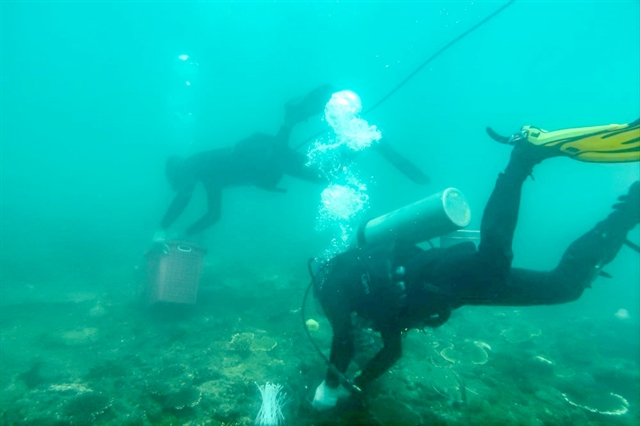The coral reef in the Côn Đảo National Park is recovering following the implementation of a project since May 2018, according to the board that has been running it.

Transplanting coral in the Côn Đảo National Park in Bà Rịa – Vũng Tàu Province. – VNA/VNS Photo
The effort, by the national park in the southern province of Bà Rịa-Vũng Tàu and the Nha Trang Institute of Oceanography, has revived coral growth on an area of 3 hectares in three places where they had earlier been slow to recover – Đất Dốc, Tây Nam Hòn Tài and Bãi Cát Lớn.
The project, which ends this month, also provided training to the local community to enhance their awareness of marine protection and coral recovery techniques.
Speaking at a meeting to evaluate the project held recently, Trần Đình Huệ, deputy director of the park, said corals were transplanted on the seabed in Đất Dốc and Tây Nam Hòn Tài and in 150 circular concrete structures set up in reefs for organisms to live in.
According to the project management board, the coverage in the three places had reached 175-752 hard corals per 100 square metres last September, increasing from 1.5 per cent coverage rate before the start of the programme to 12 per cent now.
Five species of corals, Acropora grandis, Acropora hyacinthus, Acropora robusta, Acropora millepora, and Acropora Formosa, were chosen for transplanting in the three places.
They are estimated to have a survival rate of 81-86 per cent.
Võ Sĩ Tuấn, head of the Nha Trang Institute of Oceanography and chairman of the project, said the recovery and coverage rate in Côn Đảo have been excellent.
The park should improve the management of coral reefs and establish preserved coral areas, he said.
It should solicit investment from tourist companies for preserving and sustainably exploiting marine resources, he added.
The national park, a Ramsar site of wetlands of international importance, has more than 340 species of corals and is one of the richest and most diverse coral reefs in Việt Nam.
However, many of its reefs suffered from bleaching and died on a large scale because of rising sea temperatures in 1998, 2010 and 2016 and because of low salinity in 2005.
Many of the affected reefs could not recover naturally.
The national park is an archipelago with 16 islands located 185 km off Vũng Tàu City. It has a land area of nearly 6,000ha and water surface of 14,000ha